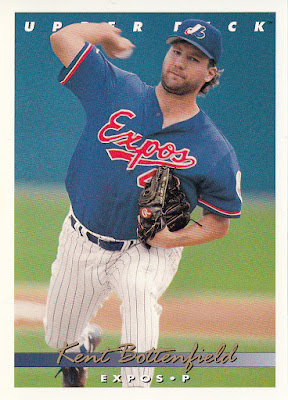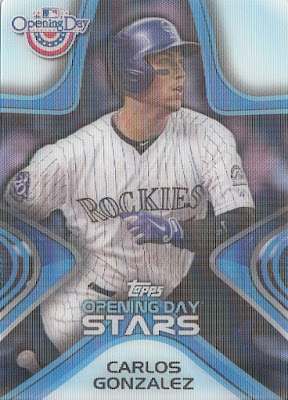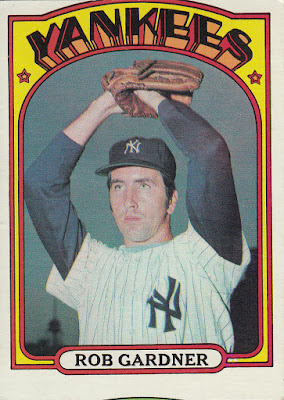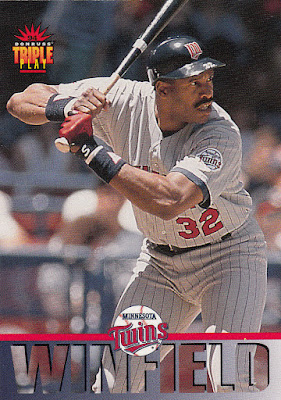We're past the two-year anniversary of Infield Fly Rule, a date in mid-January that I blew past about six posts ago (and long before the Denver Broncos won Super Bowl 50!). I did a
giveaway and everything for my first anniversary, but this one slipped my mind. Once
Off Hiatus Baseball Cards and
Bob Walk The Plank write their anniversary posts, I know I didn't miss mine by much. The three of us entered this community right around the same time, though they've both done
way more posts than I have.
But I have plenty of material to keep going, though perhaps not at the frenzied pace of others in the Cardsphere.
 |
| 1994 Triple Play #91 Moises Alou |
Material like yet another Mystery Pack from the antique mall. Obviously this one is of the Montreal Expos, the team that moved to Washington over a decade ago to become the Nationals. Perhaps no team suffered as much from the Strike as the Expos. As the 1994 season came to an abrupt close in mid-August, they had a commanding lead of the NL East, the best record in baseball, a small but passionate fan base, and a giant helping of bad timing.
Alou was one of the key members of that 1994 Expos team, but didn't get his chance to shine in the postseason until he joined the Marlins for their 1997 World Series championship. And I'm sure if you're a Cubs fan, all I have to do is say Moises Alou's name to trigger some unhappy memories. He did end up with his ring, though some other players from that team never did.
This might be the first time that I used the same set to
end one post and begin the next. 1994 Triple Play must look a bit familiar by now, as the impact of those big cutout letters can't be missed.
Also, is it just me, or does the Expos logo look like a "JB"? A kid in my third grade class used to wear an Expos hat, and I spent months wondering what the heck JB stood for. I finally did see the puffy-looking "M" in that logo, but I don't remember who finally clued me in, whether it was my classmate, my dad, or someone else entirely.
 |
| 1994 Triple Play #289 Cliff Floyd |
Anyway, I thought I knew 1994 Triple Play pretty well until I saw this Rookie Revue subset card. It's part of the base set, but it's the first time I ever ran across anything like it. Upper Deck did some Star Rookie subsets that looked pretty much like this, didn't they?
 |
| 1994 Upper Deck Electric Diamond #19 Michael Jordan |
That's right, 1994 Upper Deck! Those are some pretty similar designs, which makes me wonder if one copied the other, or if they came to this independently. Of course, this is one of Michael Jordan's more well-known baseball cards (perhaps second only to his 1991 Upper Deck card), but this happens to be the Electric Diamond parallel—UD's answer to Topps Gold.
 |
| 1993 Ultra #420 John Wetteland |
Alou and Floyd both won their World Series rings with the '97 Marlins, Jordan almost has too many NBA championships to count (fine, six), and Wetteland took home MVP honors for the 1996 Yankees, their first World Series in almost twenty years. Wetteland was a stellar closer, though he passed the baton to the legendary Mariano Rivera after that.
I am guessing that this photo from 1993 (not 1992!) Fleer Ultra was taken at Wrigley Field. The slope of that foul territory wall looks about right, and it's definitely a day game, still a common thing in Chicago. Plus Fleer shot a ton of photos in Wrigley Field. Go check 1991 Fleer Ultra to see what I mean.
 |
| 1993 Topps #69 John Vander Wal |
We saw a card of John Vander Wal not long ago, as one came via
trade from
Brad. But before he was a Rockie, he was an Expo, reaching the Bigs for the team that drafted him.
Flip this card over and you'll see a strong influence from Leaf's Studio brand, as we get John's player data, complete professional stats, and fun facts like how he studied Civil War History, and enjoys snowmobiling and RC cars and airplanes in his free time.
If that's not a complete ripoff of 1991-1993 Studio, I don't know what is.
Topps has consistently been my favorite card brand, and honestly, if someone besides them had the exclusive MLB license right now I might be less interested in the hobby, but you have to admire all the competition and one-upmanship that was going on back then. Sure, they all printed billions of cards that are now pretty much worthless, but there was a firestorm of new ideas that hit the hobby in the space of a very few years. Pictures on the back and white card stock from Score in 1988, holograms from UD in 1989, right through the first relics and serial numbered cards in the mid 1990s.
Compared to that, new sparkly patterns and border colors don't really capture the imagination in the same way as seeing competitors push the limits of innovation. Or even blatantly rip off each other's ideas.
 |
| 1993 Topps #89 Eric Anthony |
Whoops, looks like an Astro snuck into this pack!
Though their team colors are quite different, and they played home games about two thousand miles apart, "Astros" and "Expos" sound enough alike to be confused from time to time. As I recall, my dad often mixed the two up, so whoever put this pack together had the same thought process. But I still have to pause when considering whether the Astros are playing an interleague game or not.
 |
| 1991 Score #210 Tim Wallach |
1991 Score is on my list of
completed sets, so like everyone's Tim Wallach extras, this one will be headed to Corey at the
Stackhouse Law Office. Happy to help the cause!
 |
| 1993 Upper Deck #635 Kent Bottenfield |
I don't know if Kent Bottenfield has British ancestry, but his name certainly
sounds British. And not long after this card was printed, the Rockies traded a 2-8 Butch Henry to Montreal for Bottenfield, who ended up going a decent 6-6 in two seasons for the Rockies. One of those eight losses that Henry gave up was
June 15, 1993, a game Tim Wallach also happened to play in.
Turns out a decent number of these Expos guys made it to Denver at some point in their careers. And we're not done yet!
 |
| 1994 Collector's Choice Silver Signature #293 Rondell White |
I don't remember much about Rondell White other than recognizing his name from a bunch of Expos cards in 1993-1994, though he had a surprisingly long career, and even made it to an All-Star Game in 2003. Just one of those guys that would pop up from time to time on some random team and you'd wonder aloud, "Oh, is that guy still playing?"
The image on this Silver Signature card was probably taken during his rookie year of 1993. He's just a righty, but it looks like he's wearing a switch-hitter's helmet with ear flaps on both sides. But if you look really closely, you'll notice that he's using Tim Wallach's bat!
I'm actually starting to have a bit of an affinity for this Wallach fellow. He's turning up
everywhere. That's the third time he's turned up in this post alone.
 |
| 1993 Score #488 B.J. Wallace |
Remember that
Kirby Puckett insert from 1993 Score I had never seen before? Well, here's a subset from 1993 Score I have never seen before. I have a good sixty-plus cards from that set, plus a few from the Dream Team subset, and plenty of the caricature All Star cards, but never a Draft Pick card. B.J. Wallace was picked third overall in 1992, but never made it past Double-A.
At least Greg Reynolds, picked second overall by the Rockies in 2006 ahead of Kershaw, Scherzer, and others, made it to the Majors. To snag B.J. Wallace, the Expos passed on Jason Kendall, Charles Johnson, Johnny Damon, Preston Wilson, Jeffrey Hammonds, and, most notably, Derek Jeter.
Oops. Clearly the best in the business get it wrong pretty often.
 |
| 1993 Topps Black Gold #7 Marquis Grissom |
1993 marked the debut of Topps Black Gold,
the awesome insert set of my childhood. I pulled a few of them from packs, but I always stared longingly at the Ken Griffey, Jr. in the card shop, the one that always had a pretty hefty price tag for a nine-year old.
A guy like Marquis Grissom was much more reachable, and like many Expos players of this era, he did go on to win a World Series after the strike. In fact, he did so the very next year with the Braves, the only time Atlanta won a World Series during their decade-plus of dominating the NL East.
 |
| 1993 Topps Black Gold #22 Larry Walker |
Sadly, unlike many of the players you see in this post, Larry Walker never won a World Series. In fact, he never even won a World Series game, as the Cardinals were swept by the curse-breaking Red Sox in 2004, his only appearance in the Fall Classic. The Cardinals did end up winning in 2006, one year after Walker's retirement. That has to be quite a disappointment for a borderline Hall of Fame candidate. Still, he was a well-liked player in Colorado, one of the few stars to play in both the Blake Street Bomber era and as a contemporary of Todd Helton.
If I had a time machine, or at least an alternate-universe machine, I'd want to see what would have happened in 1994. And I bet Larry Walker would too.





































